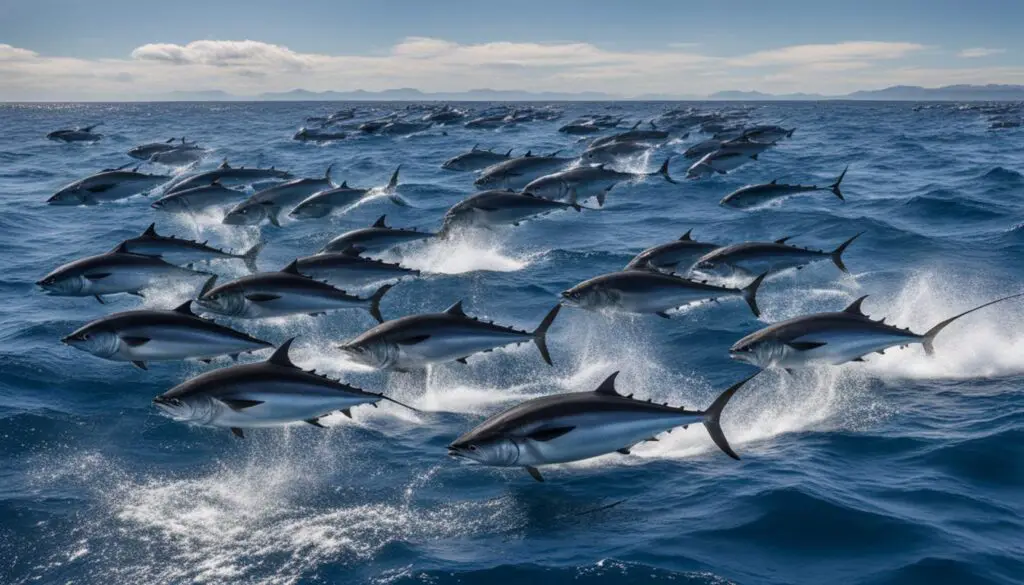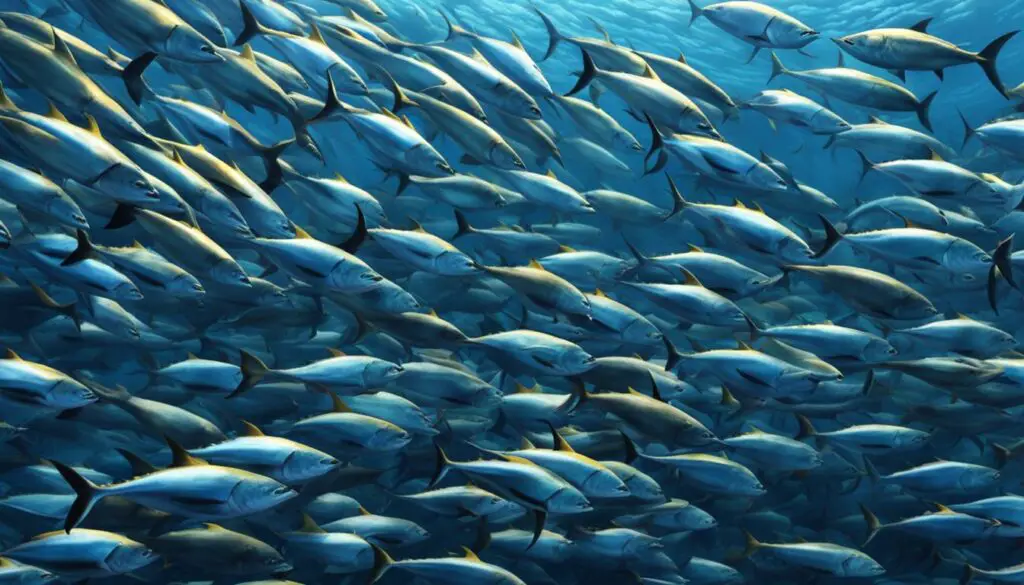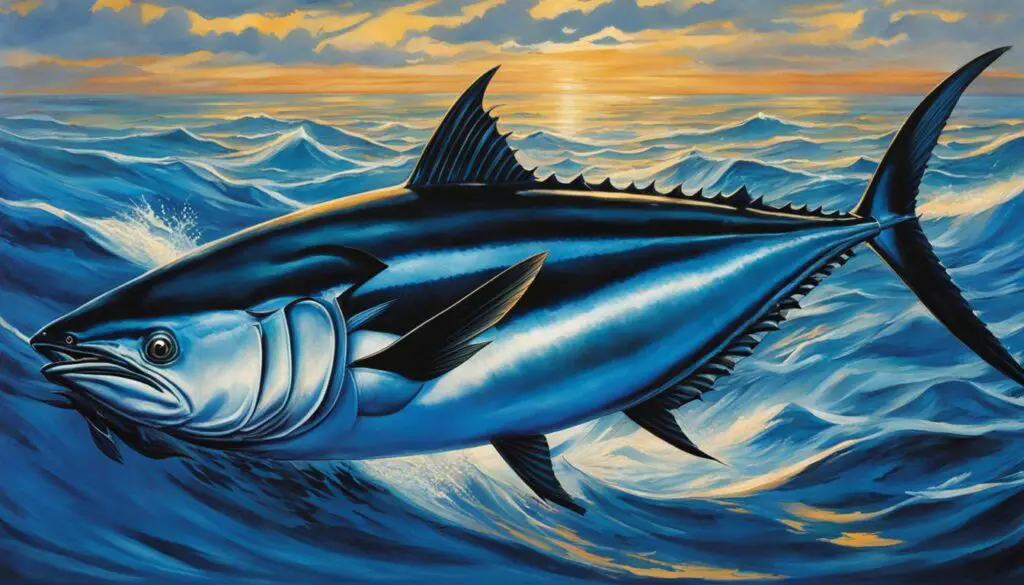The Atlantic bluefin tuna, scientifically known as Thunnus thynnus, is a truly remarkable fish that can be found in various habitats around the world. These majestic creatures are warm-blooded, allowing them to thrive in both cold waters off Newfoundland and Iceland, as well as the tropical waters of the Gulf of Mexico and the Mediterranean Sea.
Bluefin tuna have adapted to a variety of ocean environments and can be found in a range of depths, from surface waters to depths exceeding 3,000 feet. They utilize different habitats for spawning, foraging, and migration, making them a fascinating species to study.
Key Takeaways:
- Bluefin tuna have a wide distribution and can be found in various habitats, from cold to tropical waters.
- They are highly migratory and undertake trans-Atlantic crossings multiple times a year.
- Bluefin tuna utilize different habitats for spawning, foraging, and migration.
- They can be found in a range of depths, from surface waters to depths exceeding 3,000 feet.
- Understanding the habitat preferences and migration patterns of bluefin tuna is crucial for their conservation.
Atlantic Bluefin Tuna Habitat and Physical Characteristics
The Atlantic bluefin tuna, known for its impressive physical characteristics, can be found in various habitats around the world. These majestic fish have torpedo-shaped, streamlined bodies that are built for speed. With metallic blue coloring on their tops and shimmering silver-white coloring underneath, they are truly a sight to behold.
The Atlantic bluefin tuna can reach lengths of up to 6.5 feet and weigh as much as 550 pounds, although larger specimens are not uncommon. However, overfishing has significantly reduced their numbers, pushing some populations to the brink of extinction. Despite their size, bluefin tuna are highly adaptable and can thrive in both cold and warm waters, making them a truly remarkable species.
These incredible fish can be found in a range of depths, from surface waters to depths exceeding 3,000 feet. They utilize different habitats for spawning, foraging, and migration, showcasing their ability to adapt to various ocean environments. Whether it’s the cold waters off Newfoundland and Iceland or the tropical waters of the Gulf of Mexico and the Mediterranean Sea, bluefin tuna can be found in these diverse habitats.
Bluefin Tuna Migration Patterns
Bluefin tuna are known for their remarkable migratory behavior and trans-Atlantic crossings. These magnificent creatures undertake long journeys, swimming from North American to European waters multiple times a year. Tagged specimens have been tracked completing the trans-Atlantic crossing in less than 60 days, showcasing their impressive swimming abilities and endurance.
Bluefin tuna exhibit complex migratory patterns, utilizing different routes and areas for various life stages. They rely on specific habitats for spawning, foraging, and migration, each serving a vital purpose in their survival and population dynamics. The migratory patterns of bluefin tuna play a crucial role in their overall life cycle and contribute to the health and abundance of their populations.
Migratory Behavior and Adaptations
- Bluefin tuna have a strong homing instinct, returning to the same area where they themselves hatched to spawn.
- They are highly adaptable and can thrive in both cold and warm waters, allowing them to access different ocean environments throughout their migratory journey.
- Bluefin tuna’s ability to regulate their body temperature as warm-blooded fish enables them to navigate through varying water temperatures encountered during their migrations.
- They utilize their keen senses, including a sharp vision, to navigate and locate suitable foraging areas along their migratory routes.
Bluefin tuna’s impressive migratory patterns showcase their adaptability, endurance, and incredible navigation skills. Their ability to complete trans-Atlantic crossings in a relatively short time frame is a testament to their remarkable swimming capabilities.
The migratory behavior of bluefin tuna is not only a fascinating natural phenomenon but also crucial to their survival. Understanding their migration patterns and the factors that influence them is essential for developing effective conservation measures to protect and sustain their populations for generations to come.

Bluefin Tuna Spawning Grounds
Bluefin tuna have specific spawning grounds where they reproduce each year. In the Atlantic Ocean, bluefin tuna spawn in two main stocks: the western stock and the eastern stock. The western stock spawns mainly in the Gulf of Mexico, from mid-April to June, while the eastern stock spawns in the Mediterranean Sea from May to July. It is interesting to note that bluefin tuna always return to the same area where they themselves hatched to spawn. These spawning grounds are essential for the survival and replenishment of bluefin tuna populations.
Bluefin tuna have specific spawning grounds where they reproduce each year.
Understanding the reproductive habits and breeding areas of bluefin tuna is crucial for conservation efforts. By pinpointing these spawning grounds, scientists and conservationists can work towards protecting these areas and ensuring the continued survival of bluefin tuna. Additionally, studying the reproductive habits of bluefin tuna provides valuable insights into their life cycle and population dynamics.
Reproductive Habits and Breeding Areas
- Bluefin tuna spawn in the Gulf of Mexico and the Mediterranean Sea.
- The western stock spawns from mid-April to June.
- The eastern stock spawns from May to July.
- Bluefin tuna return to the area they hatched to spawn.
Preserving and protecting these breeding areas is crucial for the future of bluefin tuna. By implementing sustainable fishing practices and conservation measures in these spawning grounds, we can ensure the long-term survival of this remarkable species. It is our responsibility to safeguard the bluefin tuna population and preserve their breeding habitats for future generations.
Bluefin Tuna Foraging Areas
Bluefin tuna are remarkable creatures with diverse feeding habits and a voracious appetite. They play an important role in marine ecosystems as top-tier predators, shaping the dynamics of the food chain. Bluefin tuna forage in a range of areas, utilizing different habitats depending on the availability of prey and other environmental factors.
These powerful fish feed on a variety of prey, including smaller fish like herring, mackerel, and anchovies. They also consume squid, eels, and crustaceans, showcasing their ability to adapt to different food sources. Bluefin tuna have even been observed eating kelp and filtering zooplankton, showcasing their versatility as foragers.
The foraging areas of bluefin tuna include surface waters as well as depths up to 1,000 meters. They employ their sharp vision and efficient hunting techniques to locate and capture their prey. By utilizing different foraging areas, bluefin tuna can meet their energetic demands and ensure their continued survival in their natural habitat.

Diet of Bluefin Tuna
- Smaller fish such as herring, mackerel, and anchovies
- Squid
- Eels
- Crustaceans
- Kelp and zooplankton
Bluefin tuna are versatile foragers, capable of adapting to different food sources and habitats. Their feeding habits contribute to the balance within marine ecosystems and highlight their role as top predators.
Threats to Bluefin Tuna and Conservation Efforts
The majestic bluefin tuna faces numerous threats, with overfishing being the most significant concern. The high demand for bluefin tuna, particularly in Japan, has led to unsustainable fishing practices, resulting in a rapid decline in population numbers. The combination of overfishing and illegal fishing has pushed some bluefin tuna stocks to the brink of extinction.
To address this critical issue, conservation efforts have been implemented to protect and restore bluefin tuna populations. The establishment of the International Commission for the Conservation of Atlantic Tunas (ICCAT) is a significant step towards regulating and managing bluefin tuna fishing. The ICCAT sets fishing quotas, implements measures to combat illegal fishing, and monitors the population status to ensure sustainable fishing practices.
Further initiatives are being taken at the national and international levels to promote bluefin tuna conservation. Stricter fishing regulations are being implemented to control the catch, size limits, and fishing seasons. Improved monitoring and enforcement are crucial to prevent illegal fishing practices and protect vulnerable bluefin tuna populations. Public awareness campaigns are also vital in promoting sustainable fishing practices and encouraging responsible consumer choices.
“The future of bluefin tuna hinges on effective conservation initiatives and sustainable fishing practices. By taking action now, we can help secure a brighter future for bluefin tuna and the diversity of marine life that depends on their existence.”
Conservation Efforts in Action
Several successful initiatives have showcased the positive impact of conservation efforts on bluefin tuna populations. The recovery of some eastern Atlantic stocks is a testament to the effectiveness of conservation measures. These conservation successes demonstrate the potential for population recovery when sustainable fishing practices are implemented.
- Quota systems: Setting fishing quotas limits the number of bluefin tuna that can be caught, ensuring a sustainable level of harvesting.
- Monitoring and enforcement: Increased surveillance and stricter enforcement of fishing regulations help deter illegal fishing activities.
- Protected areas: Designating marine protected areas can provide safe havens for bluefin tuna to spawn and replenish their populations.
- Collaborative research: Collaborative efforts between scientists, fishermen, and policymakers contribute to a better understanding of bluefin tuna ecology and aid in the development of effective conservation strategies.
While progress has been made, continued and enhanced conservation efforts are necessary to secure the future of bluefin tuna. It is crucial to strike a balance between sustainable fishing practices and the economic interests associated with this iconic species. By preserving bluefin tuna populations, we not only protect the species itself but also maintain the health and integrity of entire marine ecosystems.
Bluefin Tuna as Top-tier Predators and Ecosystem Importance
The majestic bluefin tuna plays a vital role in marine ecosystems as a top-tier predator. With their sharp vision and impressive hunting skills, they help regulate prey populations and maintain the delicate balance within the food chain. Their feeding habits and predatory behavior shape the structure and dynamics of the ecosystems they inhabit.
Bluefin tuna’s position as a top predator gives them immense influence over the marine food web. They feed on smaller fish like herring, mackerel, and anchovies, as well as squid, eels, and crustaceans. In turn, they prevent any one prey species from becoming dominant and ensure the overall stability of the ecosystem. This top-down control of the food chain is crucial for maintaining biodiversity and the health of the ocean environment.

Ecosystems that harbor bluefin tuna greatly benefit from their presence. As apex predators, they help control the abundance and behavior of their prey, preventing overgrazing of vegetation and maintaining a healthy balance. By regulating the population dynamics of their prey, bluefin tuna contribute to the overall resilience and stability of the ecosystem.
The Role of Bluefin Tuna in the Food Chain
Bluefin tuna occupy a crucial position in the food chain, as both predators and prey. They are a sought-after meal for apex predators such as sharks, whales, and large predatory fish. Their presence in the food chain provides sustenance for these predators and helps maintain the balance of the marine ecosystem. The loss of bluefin tuna could disrupt the delicate interdependencies within the food chain, potentially leading to cascading effects on other species and ecosystems.
“Bluefin tuna are formidable predators, capable of striking with lightning speed and precision,” says marine biologist Dr. Sarah Johnson.
They are highly efficient hunters, using their keen eyesight to spot and pursue their prey. Their ability to adapt their foraging behavior to different environmental conditions makes them true masters of the marine food chain.
Preserving the bluefin tuna population is not just crucial for the species itself, but for the entire marine ecosystem. It is a responsibility we must all embrace to ensure the continued balance and health of our oceans.
Unique Characteristics and Adaptations of Bluefin Tuna
Bluefin tuna, also known as Thunnus thynnus, possess a remarkable set of unique characteristics and adaptations that contribute to their survival and success in their ocean habitats. One of the most fascinating features of bluefin tuna is their warm-blooded nature, a rare trait among fish. This adaptation allows them to maintain a higher body temperature and thrive in a wide range of ocean environments, from the cold waters off Newfoundland to the tropical regions of the Gulf of Mexico and the Mediterranean Sea.
Bluefin tuna’s warm-bloodedness is complemented by their highly advanced circulation system, which helps them retain heat in their muscles. This unique adaptation enables them to swim in cold waters and undertake long migrations, such as the trans-Atlantic crossings observed in their migratory patterns. Their fast metabolism and efficient digestion further support their high energy requirements as top predators in the marine ecosystem.
Notable characteristics:
- Warm-blooded nature, allowing them to thrive in various ocean environments
- Torpedo-shaped, streamlined bodies for speed and agility
- Metallic blue coloring on top and shimmering silver-white coloring on the bottom
- Impressive sizes, reaching up to 6.5 feet in length and 550 pounds in weight
With their unique characteristics and adaptations, bluefin tuna shape the dynamics of marine ecosystems as top-tier predators. Their decline due to overfishing necessitates urgent conservation efforts and sustainable fishing practices to ensure their long-term survival and preserve the diversity of marine life that depends on their existence.

“Bluefin tuna possess remarkable adaptations and characteristics that set them apart from other fish species. Their warm-blooded nature, advanced circulation system, and efficient metabolism allow them to thrive in various ocean environments and undertake long migrations. Preserving their habitats and implementing sustainable fishing practices are crucial for the future of bluefin tuna.”
The Future of Bluefin Tuna and Conservation Efforts
As we look to the future, the conservation of bluefin tuna is of utmost importance. With some populations already showing signs of recovery, it is crucial to continue and expand conservation initiatives to ensure the long-term survival of this iconic species.
Efforts are underway to implement sustainable fishing practices that prioritize the health and abundance of bluefin tuna populations. By adopting practices such as catch limits, size restrictions, and seasonal closures, we can help protect spawning grounds and ensure the replenishment of bluefin tuna stocks.
Furthermore, conservation organizations are working tirelessly to raise public awareness about the importance of bluefin tuna and the need to preserve their habitats. Through educational campaigns and community engagement, we can inspire individuals to become stewards of the ocean and take action to support sustainable fishing practices.
By coming together and taking proactive measures, we can pave the way for bluefin tuna population recovery and secure a sustainable future for these magnificent creatures. Let us remember that the fate of bluefin tuna is in our hands and that our efforts today will determine the legacy we leave for future generations.
FAQ
Where do bluefin tuna live?
Bluefin tuna can be found in various habitats around the world, including the cold waters off Newfoundland and Iceland, the tropical waters of the Gulf of Mexico and the Mediterranean Sea, and depths exceeding 3,000 feet.
What are the physical characteristics of bluefin tuna?
Bluefin tuna have torpedo-shaped, streamlined bodies built for speed, with metallic blue coloring on top and shimmering silver-white coloring on the bottom. They can reach lengths of up to 6.5 feet and weigh as much as 550 pounds.
What are the migration patterns of bluefin tuna?
Bluefin tuna are highly migratory and have been tracked swimming from North American to European waters several times a year. They undertake trans-Atlantic crossings, completing the journey in less than 60 days.
Where do bluefin tuna spawn?
Bluefin tuna spawn in specific areas each year. The western stock spawns mainly in the Gulf of Mexico from mid-April to June, while the eastern stock spawns in the Mediterranean Sea from May to July.
What do bluefin tuna eat?
Bluefin tuna have a diverse diet, feeding on smaller fish like herring, mackerel, and anchovies, as well as squid, eels, crustaceans, kelp, and zooplankton.
What are the threats to bluefin tuna and what conservation efforts are being made?
Overfishing, particularly due to the high demand for their meat, has severely impacted bluefin tuna populations. International conservation efforts, including the establishment of the International Commission for the Conservation of Atlantic Tunas (ICCAT), aim to regulate and manage bluefin tuna fishing to ensure sustainable practices.
What is the role of bluefin tuna in marine ecosystems?
Bluefin tuna are top-tier predators that play a crucial role in regulating prey populations and maintaining the balance within the food chain. They shape the structure and dynamics of the ecosystems they inhabit.
What are the unique characteristics and adaptations of bluefin tuna?
Bluefin tuna are warm-blooded, a rare trait among fish, which allows them to thrive in various ocean environments. They also have a fast metabolism, efficient digestion, and advanced circulation system that helps them retain heat in their muscles.
What is being done to ensure the future of bluefin tuna?
Conservation initiatives, stricter fishing regulations, improved monitoring and enforcement, and public awareness campaigns are being implemented to protect and conserve bluefin tuna populations and their habitats.

